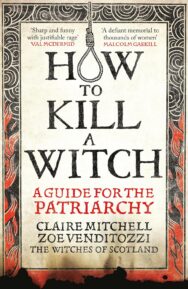‘The issue has struck a chord with thousands of people and we’re delighted to have ignited this cultural conversation to recognise not only this historic miscarriage of justice, but also contemporary inequalities for the vulnerable generally, and women in particular.’
Claire Michell and Zoe Venditozzi’s campaign for official recognition of the miscarriage of justice in the country’s historical witch trials has been far-reaching and hugely influential. They have now taken their investigations, knowledge and craft in bringing together their book, How to Kill a Witch, which was released earlier this month. BooksfromScotland caught up with Zoe Venditozzi to discuss the book and campaign.
How to Kill a Witch: A Guide for the Patriarchy
By Claire Mitchell & Zoe Venditozzi
Published by Monoray
Hello Zoe. Congratulations of the publication of How to Kill a Witch – it feels a long time coming! We’ve been aware of your work since you started your podcast, The Witches of Scotland. Did you always want to put your explorations into print?
I’ve got a background as a fiction writer and Claire does a lot of factual legal writing, so it always felt like there would be a written element to what we were doing. However it was only when our now editor approached us and set deadlines that we took it seriously, knuckled down and got writing!
For our readers who don’t know, can you tell us how you started working together?
Claire initially came up with the idea and aims of the Witches of Scotland campaign when she was struck by how lacking in representation Scotland’s women are. This gelled with some research Claire was doing on an aspect of legal history when she read the testimony of a woman accused of being a witch who asked of her jailers if it was ‘possible to be a witch and not know it?’ This was presumably a desperate attempt to clear herself of her charges. When we met some weeks later, we bonded over our love of true crime podcasts and passion for justice and a movement was born.
It’s interesting to read early in your introduction that you were writing your book as a joke guide for the Patriarchy! What made you pivot to the book we have now?
We always planned to write the history of the witch trials with the often arch tone that remains but, as often happens as you write a book, something happens on the page that leads you in a different direction. As I wrote the fiction pieces and pen portraits, Claire ‘translated’ demonology and The Newes From Scotland into more modern language, the book began to take on its real shape. Naturally, we kept the great title!
How to Kill a Witch opens with a poem from Len Pennie, has brilliant fictional vignettes, and cheeky footnotes throughout; it has its historical narrative, portraits, but it also makes serious points about the status of women in society. Why did you approach the book with a patchwork of styles with the content?
One of the campaign and podcast’s compelling aspects, is that we go where the story and our interests take us. The evolution of the book was very similar in that we played to our strengths and fascinations and followed the narrative where it led us.
It blows our mind that the Witchcraft Act of 1735 was only repealed in 1951, and yet the witch trial period seems mainly contained to the 16th to 18th centuries. What do you think were the special circumstances that generated this moment in history?
In Scotland, the act was repealed in 1736 after being signed into law in 1563. Long story short, the five big peaks of accusations in Scotland were down to a horrific combination of great social change; an obsessed traumatised king, the prevailing belief system; ready access to law courts and a zealous, perturbed populace. When things get tough, humans look for scapegoats to make sense of difficulty and to have someone to blame. This didn’t end with the Scottish witch trials.
The story of Helen Duncan, the last woman tried under the Witchcraft Act in the UK is fascinating. What are your thoughts on this last hurrah for these persecutions?
Helen Duncan is a sad case where she was used as an example of how not to behave in times of war. She was thought to be encouraging loose talk and her case was a show trial that made an example of her. Fascinating but very unfortunate.
How to Kill a Witch also outlines where accusations of witchcraft still exist. How do we begin to tackle the superstitious and conspiratorial thinking that perpetuates this oppression?
Critical thinking! It’s key to this issue that we think beyond belief systems and take rational approaches to social issues and human fears.
As well as the book, there have been campaigns for statues, an official government recognition of the injustices of the witch trials, and honorary doctorates. Did you ever envision such results in your campaigning?
Not in a million years would we have imagined the huge, international interest in the campaign. The issue has struck a chord with thousands of people and we’re delighted to have ignited this cultural conversation to recognise not only this historic miscarriage of justice, but also contemporary inequalities for the vulnerable generally, and women in particular.
What next for the campaign? What are your hopes in the reception of the book?
Our aim is to keep educating, keep engaging and to keep being quarrelsome dames intent on smashing the patriarchy.
How to Kill a Witch: A Guide for the Patriarchy by Claire Mitchell & Zoe Venditozzi is published by Monoray, priced £20.














